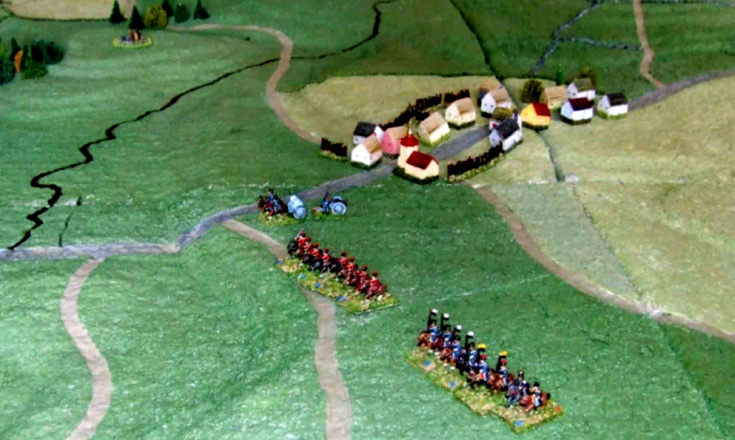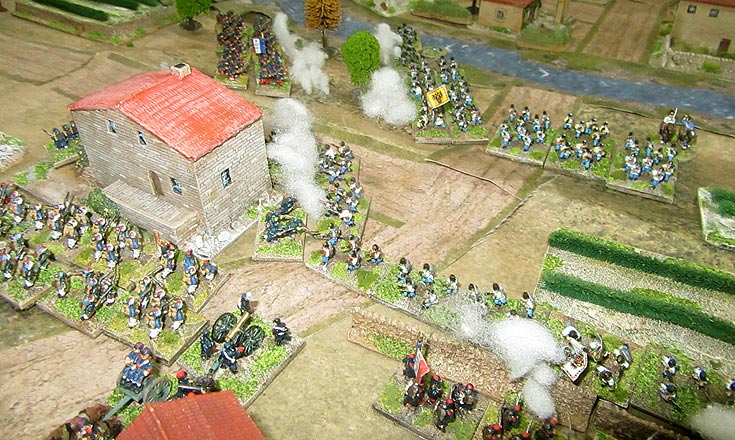
The Battle of Nachod, 1866
4th December 2012, 0 Comments
Bismarck’s Wars, Field of Battle, 10mm
Back in August I helped Gerry Henry playtest his rules for the Austro-Prussian War of 1866. This small Sunday game was another chance to tweak the rules, and we fought over the same little patch of Bohemia, around the village of Wenzelsberg. Now, I’m not particularly a fan of the smaller scales, as I prefer the visual charm of 28mm figures. However, what this scale does allow for is the sweep of terrain, and the chance to fight large-scale actions with small-scale figures. Gerry plans a larger game a week before Christmas, and so I was press-ganged into service to play the part of the Prussians. Did I ever tell you that my great-grandfather was with the Prussian reserve artillery at the Battle of Koniggratz? No? Well, that’s a story for another day. Anyway, this little affair centred around an Austrian assault on the Prussian-held village of Wenzelsberg, a few miles south of the Nachod defile. I had an infantry brigade of two three-battalion regiments to hold the town with, supported by a battalion of jaegers. Marching to the sound of the guns was the second brigade of the division, supported by the divisional cavalry and guns. These divisional assets were my first reinforcements, and the artillery raced to deploy on the hill above the village, while the cavalry strung themselves out along a ridge to the north, covering the southern approaches to the Nachod defile. That’s them in the photo up above, while on the left one of my Prussian regiments, seeing off a skirmishing battalion of Austrian jaegers.
I had an infantry brigade of two three-battalion regiments to hold the town with, supported by a battalion of jaegers. Marching to the sound of the guns was the second brigade of the division, supported by the divisional cavalry and guns. These divisional assets were my first reinforcements, and the artillery raced to deploy on the hill above the village, while the cavalry strung themselves out along a ridge to the north, covering the southern approaches to the Nachod defile. That’s them in the photo up above, while on the left one of my Prussian regiments, seeing off a skirmishing battalion of Austrian jaegers. The Austrians have a couple of advantages in this period – the quality of their artillery, and the experience of their cavalry. Both can be potential battle-winners if used correctly. The Austrian guns pummeled the village, and the troops deployed along the wood line to the north, and then the storm columns were sent in. That was when the Prussian strength was revealed – the effectiveness of their needle guns, and hence of their infantry firepower. In the northern attack the Austrian jaegers were forced back with heavy casualties. While one Prussian battalion broke under the fire of the Austrian artillery, the others held their ground, and saw off the attack. The way Field of Battle works is that both players draw a number of cards, one at a time, and these dictate when you can move, fire, reload or charge etc. Some of them are kept back for when you need them – like “inspired leadership” (+1 to firing or melee) or “schnellfeuer” (an extra Prussian volley). Playing both of these at the right moment can make the Prussian infantry devastatingly effective.
The Austrians have a couple of advantages in this period – the quality of their artillery, and the experience of their cavalry. Both can be potential battle-winners if used correctly. The Austrian guns pummeled the village, and the troops deployed along the wood line to the north, and then the storm columns were sent in. That was when the Prussian strength was revealed – the effectiveness of their needle guns, and hence of their infantry firepower. In the northern attack the Austrian jaegers were forced back with heavy casualties. While one Prussian battalion broke under the fire of the Austrian artillery, the others held their ground, and saw off the attack. The way Field of Battle works is that both players draw a number of cards, one at a time, and these dictate when you can move, fire, reload or charge etc. Some of them are kept back for when you need them – like “inspired leadership” (+1 to firing or melee) or “schnellfeuer” (an extra Prussian volley). Playing both of these at the right moment can make the Prussian infantry devastatingly effective. The Prussians were less fortunate over on their left flank, where a solitary battalion held the edge of a wood, while the two other battalions from the same regiments occupied Wenzelsberg. The Austrians attacked with a whole brigade in storm column, one of which worked its way around the flank of the Prussian unit. While the defenders saw off the Austrians charging them from the front they couldn’t prevent the Austrians hitting them in the flank. The Prussians broke and ran. Worse, the Prussian divisional artillery sited on the high ground above the village was unable to fire on the Austrians, as they were masked by trees. As the Austrians massed for an assault on the village the defenders made the mistake of firing at them, and although it stopped one attacking unit in its tracks the rest continued their advance. Of course the reload card didn’t appear before the Austrians launched their assault. The result was a furious melee, and the Prussians were forced back. More by luck than judgement – or rather some exceptionally good dice – the second round of melee saw the Austrians ejected from the village in disorder. The Prussians continued to hold the objective village – but only just.
The Prussians were less fortunate over on their left flank, where a solitary battalion held the edge of a wood, while the two other battalions from the same regiments occupied Wenzelsberg. The Austrians attacked with a whole brigade in storm column, one of which worked its way around the flank of the Prussian unit. While the defenders saw off the Austrians charging them from the front they couldn’t prevent the Austrians hitting them in the flank. The Prussians broke and ran. Worse, the Prussian divisional artillery sited on the high ground above the village was unable to fire on the Austrians, as they were masked by trees. As the Austrians massed for an assault on the village the defenders made the mistake of firing at them, and although it stopped one attacking unit in its tracks the rest continued their advance. Of course the reload card didn’t appear before the Austrians launched their assault. The result was a furious melee, and the Prussians were forced back. More by luck than judgement – or rather some exceptionally good dice – the second round of melee saw the Austrians ejected from the village in disorder. The Prussians continued to hold the objective village – but only just. Having sorted themselves out and recovered from their casualties the first Austrian attack went in again to the north of the village. Yet again the Austrian storm columns were seen off by timely rifle fire, and so the village remained in Prussian hands for the rest of the game. Further to the north both sides had brought on another brigade, and the Prussian infantry busied themselves taking over from the cavalrymen guarding the ridge between Wenzelberg and Nachod. A small horse artillery battery was amusing itself firing on the Austrian columns, and the whole situation looked safely in hand. Then Gerry’s military service shone through. As a vet and a former Royal Horse Artilleryman he likes Gerry launched a regiment of Austrian hussars straight at them. They would have caught my cavalry in the flank and eviscerated them, but then I remembered that I could fire a volley from my infantry, who were moving up to take over the Ulhan’s position. The volley was just enough to stop the Austrian hussars from charging home. Better still, I then pulled the right cards from the deck, and proceeded to demolish the rest of the hapless cavalry unit. Being ex navy, give me firepower over romantic charges any time.
Having sorted themselves out and recovered from their casualties the first Austrian attack went in again to the north of the village. Yet again the Austrian storm columns were seen off by timely rifle fire, and so the village remained in Prussian hands for the rest of the game. Further to the north both sides had brought on another brigade, and the Prussian infantry busied themselves taking over from the cavalrymen guarding the ridge between Wenzelberg and Nachod. A small horse artillery battery was amusing itself firing on the Austrian columns, and the whole situation looked safely in hand. Then Gerry’s military service shone through. As a vet and a former Royal Horse Artilleryman he likes Gerry launched a regiment of Austrian hussars straight at them. They would have caught my cavalry in the flank and eviscerated them, but then I remembered that I could fire a volley from my infantry, who were moving up to take over the Ulhan’s position. The volley was just enough to stop the Austrian hussars from charging home. Better still, I then pulled the right cards from the deck, and proceeded to demolish the rest of the hapless cavalry unit. Being ex navy, give me firepower over romantic charges any time. Anyway, at that point we draw the game to a close. We’d given the rules a good try out, and they worked well. We also identified a couple of areas which could be tweaked, such as the modifiers for meleeing in built-up areas, and the way melees are fought. It was a good day out, and I’m looking forward to playing another larger game with Gerry’s teeny-tiny toy soldiers on 16th December.
Anyway, at that point we draw the game to a close. We’d given the rules a good try out, and they worked well. We also identified a couple of areas which could be tweaked, such as the modifiers for meleeing in built-up areas, and the way melees are fought. It was a good day out, and I’m looking forward to playing another larger game with Gerry’s teeny-tiny toy soldiers on 16th December.




